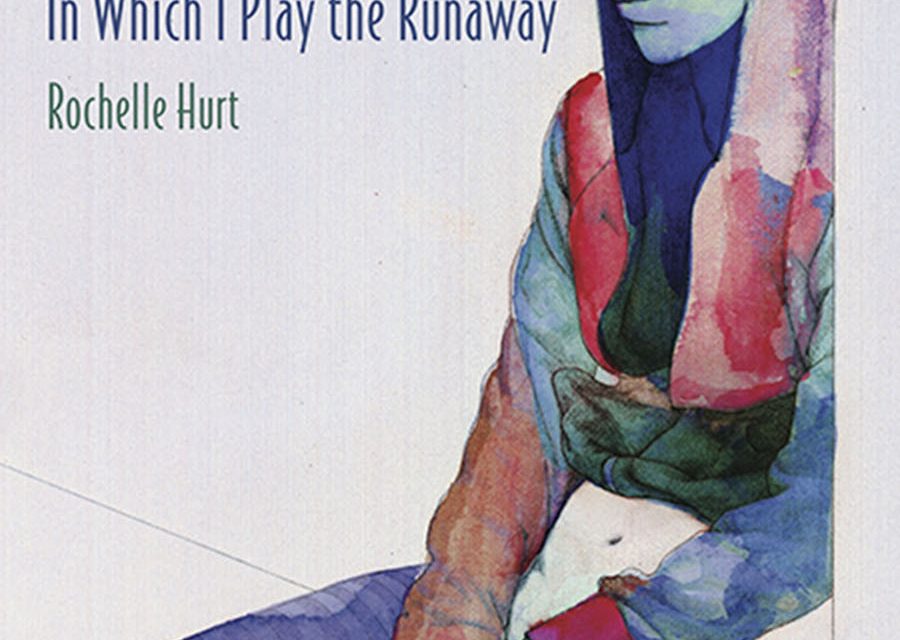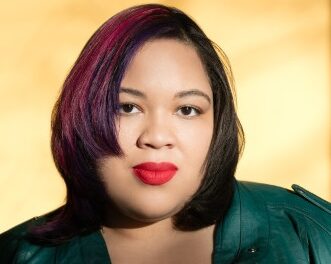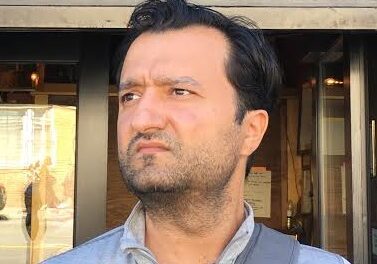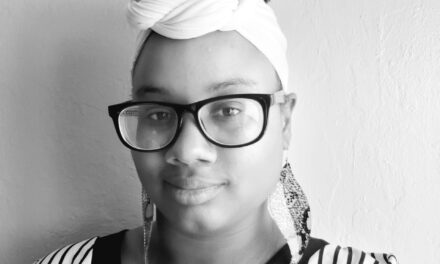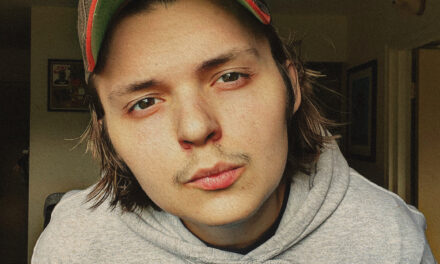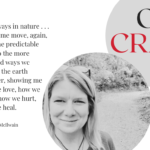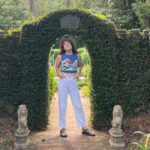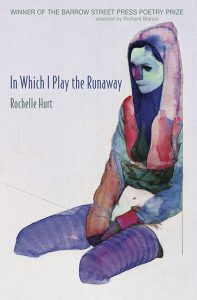 In “The Miami River Floods,” from Rochelle Hurt’s collection In Which I Play the Runaway (Barrow Street Press), the speaker addresses her father while watching footage of the Miami River flooding and speculates on the following:
In “The Miami River Floods,” from Rochelle Hurt’s collection In Which I Play the Runaway (Barrow Street Press), the speaker addresses her father while watching footage of the Miami River flooding and speculates on the following:
how many babies will be born tonight in heroic backseat
deliveries as cars float down the freeway? They will carry
those stories all their lives like everyone else—
not from memory, but narrative inheritance. How dutifully
we gulp down circumstance as fate
This idea of narrative inheritance lies at the heart of this collection whose poems challenge accepted narratives about womanhood, fairy tales, movies, and family, always with an eye toward questioning the reflex to “gulp down circumstance as fate.”
Throughout the collection, Hurt displays a deft ability to create images that allow narrative to be carried, developed, and understood on an intellectual and emotional level simultaneously. In the poem “Self-portrait in Needmore, Indiana,” for example, the reader is presented with the following:
As expected, after the wedding, the house
became a cough we lived in, trembling
in the throat of that asthmatic spring.
These three lines set a narrative, then quickly compound it. Within the logic of these lines there are implications of weakness and affliction. A ceremony of union changes the world around the poem’s characters, so that it can only be understood in terms of an afflicted body. This metaphor places the emotional charge of the poem within the body, while the imagery unfolds in a way that mirrors the sudden and unwieldy transitions of real life. This poem continues in terms of the body:
The streets stacked and curved like fingers
on a grease-knuckled hand gripping
the waist of our Midwestern dream.
The narrative of affliction continues here with the additional pressure of possessive relationships added. As the self is caught in the body, the speaker of this self-portrait (one of a series in the collection) is caught behind the narrative inheritance of marriage. The poem’s conclusion makes clear what the stakes are of being caught:
I could have died etching my name
into the glass eye of my cage—a bay
window painted with lace. The skyline
in its expanse was a farce played out each night.
Sometimes my reflection was the star
of the show. Sometimes it was the child
clapping from her seat, so looking out
and looking in became the same thing.
Sometimes it just rained for weeks.
After the description of the bay window as a “glass eye,” the poem develops the metaphor of hindered sight by presenting several shifting images. The speaker’s listing of reflections of self then of the child evokes the potential loss of self of parenting. This loss is further emphasized in the last line, where the speaker sees only rain, implying a complete loss of being able to see themselves or anyone.
While the above poem and others present a poetic sensibility capable of speaking in terms of the body, the “runaway” of the collection’s title is also present throughout offering its own language. The runaway theme runs counter to the body-centered theme and creates a push/pull effect. In “Poem in Which I Play the Runaway,” these two themes interact:
It could open with a party, strewn
with girls like tinsel, girls looking
for a house to stuff themselves in [. . .]
Or a chase scene: some ranch house
with walls thin as a mother’s dress,
long emptied of men and closing on me.
I never wanted a home in him,
but the sex was like licking sheets
of corrugated iron, my torn maw
breathing in the corrosion
Here, the speaker works out two variations on house narratives, the speaker’s voice charged with swagger and conviction as they reimagine via metaphor. The third stanza shows this reimagining impulse suddenly grounded. After the statement of not wanting “a home in him,” a statement still working on the intellectual/imaginative level, the speaker describes how “the sex was like licking sheets / of corrugated iron,” a description which brings the poem back into the body. This synesthesia mirrors the argument between the imagination and the body engaged with in this poem. The runaway theme here is embodied in the speaker’s attempts to escape narrative while acknowledging their ties to it.
It is in this tension between escape and acknowledgment where the collection’s most compelling takes on narrative inheritance occur. Over time, this tension becomes imbued with empathy, as in “Some Oz,” where the speaker meditates on how their father learned from his father how to leave as if looking for the Oz of the title:
Some Oz where the clock of your life could unwind.
But you’ve returned to us now, your hands
full of years like salvage. And how could you
have known what you’d wake to—a home
inescapable, you wearing your father’s face [. . .]
you search for a word like an opening
into some storm strong enough to take us both
to a place where your daughters can forgive you.
The runaway theme here becomes a running toward. The narrative inheritance of fathers and daughters is suspended in a way that honors the complexity of the relationship while continuing to question it. While the runaway theme implies motion, the body implies stillness; the interplay of these two themes makes for poetry capable of reimagining the world while facing it.
interview
 JAA: How would you say this collection reflects your idea of what poetry is/can be?
JAA: How would you say this collection reflects your idea of what poetry is/can be?
RH: One thing poetry can do very well is destabilize language—or use language to destabilize ideas. My favorite kind of poetry, no matter the school or style, is poetry that uses linguistic slippage and play to challenge concepts we might otherwise consider stable. A primary theme in my collection is the instability of self-image, given the precarious relationship between self, story, and place. The book is structured around a series of poems that use intriguing town names—Last Chance, Hurt, Honesty, etc.—to tease out narrative, metaphor, and persona. Many of the poems are narrative, but still rely on lyricism as an engine for moving between the town name and the self that is painted in the poem. Many of the poems also mix autobiographical confession with tale-telling and hyperbole as a means of further dislocating the self. We do get lost, I think, in the shifting narratives about where we come from, who our families are, who we could have been/are/could still be. I know I do—and I look to poetry not as a means of affirmation or comfort, but as a way of continuing to question those narratives.
JAA: What were the challenges in writing these poems and how did you work through them?
RH: Writing the individual poems was less challenging than organizing them into a book. As you can imagine, it’s somewhat difficult to structure a collection with an arc of some sort when you’re specifically trying to mess around with narrative. At first I tried to mush everything together into one clean story over three long sections, but that traditional structure just wasn’t working. I knew that if a reader approached the collection expecting a singular speaker with one coherent story to tell, that reader would be confused and disappointed. After reorganizing the collection close to twenty-five times, I decided to make six short sections guided by experiences and ideas. The speaker, in all her plural forms, moves through different places and contexts patched together from family history, memory, and fabricated stories. Emotional states and revelations are mapped onto place, and the book moves forward through this map. The arc wound up leading to a place of honesty for this speaker, as she begins to more directly confront her own tendencies toward exaggeration and fatalism. She winds up, after all, in Honesty, Ohio.
*
In Which I Play the Runaway is available for purchase from Barrow Street Press.
To find out more about Rochelle Hurt’s work, check out her site.

